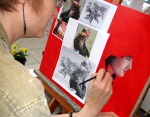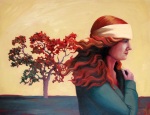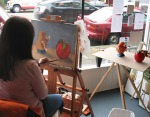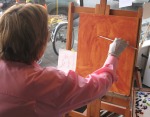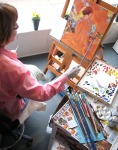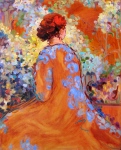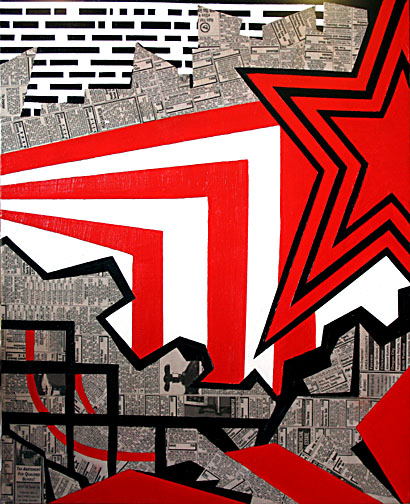Shannon bases his work on symbols and references with personal meaning or appeal. Some of these references are visual and some are word associations. The images and ideas that find their way into Shannon’s paintings often refer to his ethnic heritage, memories from travels, and objects of natural history. Shannon works primarily in oils, but often builds first layers with acrylics (especially when he needs to complete a painting more quickly) and finishes with glazes in oils. Recently, he has been incorporating more mixed media elements into his work by collaging bits of ephemera that he has found or collected.
Shannon started today by building a scumbled background with rich, dark earthtones. Onto this background, he collaged some bus tickets from a trip to Mexico, an illustration of a crown (corona) from an old label, and in the center, an illustration of a cross section of the brain (corona radiata). Shannon brought the shell of a horseshoe crab and a small animal skull as visual references. He painted almost ghostly depictions of these objects onto his background, positioned in each corner of the canvas. The final elements he added were characters from the Mayan alphabet, imagery that Shannon uses frequently in his work.
Shannon starts his paintings with specific visual references in mind, but does not usually have the whole composition planned out in advance. He allows the objects he’s chosen to suggest ideas as he works. Although he doesn’t mind explaining where his ideas come from and the specific meanings, if any, that the objects in his paintings have for him, he wants viewers to make their own associations with the imagery and the relationships between the parts. The nebulous backgrounds and floating imagery in Shannon’s work create a mysterious quality that invites viewers to ask questions and imagine possible answers about the ideas and feelings his paintings convey.
Click on thumbnails to see larger pictures.
























